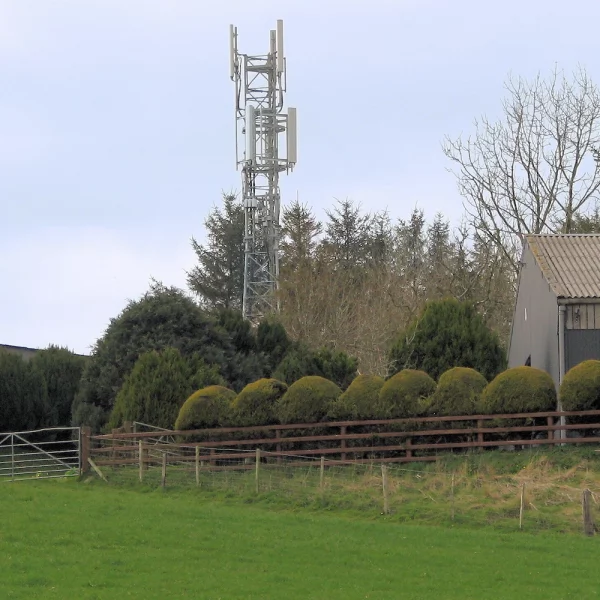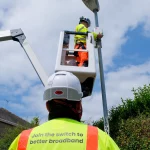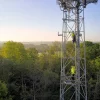Survey Claims 35 Percent of UK Landowners Don’t Want to Host 5G Mobile Masts

A new survey of 500 national landowners, which was conducted by telecoms investor AP Wireless UK – a company with a strong vested interest in this area, has claimed that 35% of respondents are considering terminating their mobile mast agreements, citing concerns over rent cuts, legal pressure and loss of trust in mobile network operators.
In the past it was not uncommon for landowners to extract highly lucrative rental agreements in return for allowing telecoms operators to deploy infrastructure on their land (e.g. mobile masts, trenches for fibre optic broadband cables etc.). But this could also make it far too expensive for network operators to expand their coverage, and thus inhibited the roll-out of new services, particularly in rural areas where network build costs are often disproportionately high.
The previous government attempt to rebalance this in 2017 by revising the Electronic Communications Code (ECC) to make it easier and cheaper for network operators to access public or private land (here) – bringing rents more in line with other utility services. But that initially swung the problem in the other direction (here and here) and resulted in some providers, particularly mobile operators, trying to force the adoption of dramatically lower rents (e.g. sometimes slashing rents worth thousands to just a few tens of pounds).
Advertisement
The situation has since been improved through various tribunal rulings and wider political efforts to find a fairer balance, which has had some modest success (e.g. here and here), although experiences do vary. Meanwhile, the Government last year signalled that they intend to make a “renewed push to fulfil the ambition of … national 5G coverage by 2030,” which would at the very least require them to retain the current approach.
However the new survey, which also appears to have secured support from the Country Land and Business Association (CLA), National Farmers’ Union (NFU), and British Property Federation (BPF), is warning that landlords are now reporting rent reductions of up to 90% and a sharp rise in disputes, with more than 1,000 legal cases triggered to date. Suffice to say, many landowners aren’t happy and are thus becoming less receptive to reform in this area.
Key Survey Findings
➤ 1 in 3 landowners may walk away: 35% are considering terminating their mast agreements, citing rent cuts, legal pressure and loss of trust.
➤ Widespread legal threats: Among landowners whose leases have already expired, 68% say they have faced legal threats or pressure.
➤ Severe rent reductions: 82% say mast income is important; many report cuts of over 80-90%, undermining financial viability.
➤ Costs rising: 34% face additional costs from hosting – disproportionately affecting schools, charities and smallholders.
➤ Older agreements at risk: Most leases pre-date 2017 and now face retroactive downgrading if the reforms expand to 15,000 more sites.
➤ Renewal uncertainty: Just 23% are very likely to renew; nearly half remain undecided.
The issue has come to the fore again because landowners are worried about the government’s proposal to expand the current model to 15,000 more sites across England, Wales and Northern Ireland via full adoption of changes in the Product Security and Telecommunications Infrastructure Act (PSTI). A decision on this expected later in the year. This issue has already resulted in land and property owners lobbying the government to suspend their reforms (here).
On the flip side, it’s important to remember that the government’s changes are all in the name of improving mobile network coverage and performance, particularly for remote communities that often suffer because operators normally find such deployments to be unviable. But sometimes the very people and organisations who complain about poor more signals, can also be those who disrupt the construction of new masts.
Advertisement
Thomas Evans, Executive Vice President at APWireless, said:
“This is a clear warning for ministers. Schools, hospitals, councils and farmers all host masts – and many are now prepared to walk away. If these proposals go ahead, thousands of sites that support mobile coverage for millions of households could be lost.
The government must hit pause and work with landowners, not against them, if it wants to avoid making Britain’s mobile connectivity crisis even worse.”
CLA President, Victoria Vyvyan, said:
“Many landowners who host mobile phone masts and support vital infrastructure don’t want to pull out of their agreements, but feel like they have little choice.
Some landowners have endured 90% rent cuts and hostile relationships, so it’s unsurprising that so few want to continue to host masts. As this survey shows, the behaviour of the mast operators has put the UK’s 5G rollout under threat and jeopardised the Treasury’s wider ambitions for economic growth and connectivity.
To close the unacceptable rural-urban digital divide the government must work to accelerate rollout, and to do that they must make sure landowners are treated fairly.”
The press release also states that “unlike previous generations of mobile infrastructure, 5G relies on a dense network of masts, many of them on private land,” which isn’t entirely accurate. Certainly, to get the most out of 5G and its support for higher frequencies (these aren’t all available yet – Ofcom will begin auctioning off the 26GHz and 40GHz bands next month), then a more complex and denser network is required. But this is more relevant to busy urban areas. In rural locations, the approach to 5G is much the same as it was for 4G, with lower and mid-band spectrum being preferable for its wider and more cost-effective geographic coverage.
Finally, it’s important to include a note whenever leasing firm AP Wireless gets mentioned (inc. the affiliated Icon Tower company), since they have some of their own vested interests in this debate that have occasionally caused a few concerns (here).
As ever, the key challenge in making all of these changes is with doing them without significantly undermining or reducing the rights of existing or potential site providers (land/property owners etc.), which is easier said than done. So far, the government has been minded to continue with the PSTI’s intended reforms , and it will be interesting to see whether they make any concessions on that.
Like it or not, the government can’t please everybody on this one, but they also need landowners to play ball.
Advertisement
Mark is a professional technology writer, IT consultant and computer engineer from Dorset (England), he also founded ISPreview in 1999 and enjoys analysing the latest telecoms and broadband developments. Find me on X (Twitter), Mastodon, Facebook, BlueSky, Threads.net and Linkedin.
« Virgin Media O2 Uncovers UK People’s Passwords in Just 3 Minutes





















































Just wait for the same landowners complaining about lack of mobile network coverage, lack of full fibre or slow unreliable internet access.
Is this the same NFU that complain about rural coverage? The fact is that a 20x20m parcel of land in the corner of a field is not worth thousands of pounds a year in rent.
Then they have a choice, forget any form of high speed connectivity and live in the very slow lane or this. In the EU so many 5G masts are seen, france, germany, spain, romania, portugal, norway.. etc have very fast 5G networks but the lot who complain about poles being put up and then want decent BB and 5G should stop complaining.
I wonder how the other countries get around these issues?
Land prices in the UK to me at least, seem artificially higher because people and developers buy up the land and sit on it, doing nothing with it. It’s the same with housing. Why would developers build more houses if it will redude the demand and thefore slow down the market and lower the prices (and profits).
Some farmers don’t want their cows exposed too 5G electromagnetic radiation, not realising it’s a load of bullocks! — hopefully. 🙂
UK are the worse bemoaning ever! Think farmer won’t care about no broadband, no mobile as they always far too busy all day all night at the farmer work!
‘… claimed that 35% of respondents…’ Same bias alert! What percentage actually responded?
Sample bias not same bias.
Thats fine, build them anyway
Most likely because they know what 5G does their cattle, plant life. Not only that but It looks ugly on there land. I wouldn’t want one.
P.S: Before you all start trothing at the mouth, this is my personal opinion.
It’s not the 5G as such! RF is and always will be the issue, not the tech being transmitted.
4G and 5G are data modes, 800MHz to 100GHz are the frequencies that are used to tranmit a carrier, be it FM, AM or SSB (Single Sideband) with a power output. Average Joe and Flat earthers don’t understand this and they blame the tech not the transmitted carrier, hence disinformation and protests.
RF is my passion, and what I understand a lot about. What gets me, is they’ll happily get bombarded by x-rays in hospital but bitch about something they just think is the cause of health issues.
So remember 4G and 5G like voice is the mode and frequencies with a carrier are the thing that is needed for the voice to be heard, the more powerful the carrier the further the signal goes, transmitted signals at 40GHz will be lower power hence the more cells needed and also the higher the frequency the shorter the distance a signal travels, but those before 1GHz the longer the distance a signal travels…. RF 101
They should never of rolled out 5G they can’t even get 4G right what they should of done was to make 4G 100% coverage and leave it as 4G and no more
I agree 100%
What travels further? 4G at 1800 or 5G at 1800? The answer is it doesn’t matter as the frequency is the same.
The 4G and 5G differences are mainly at the base stations but of course it takes time to go round replacing all this infrastructure.
Yup Phil is correct, as I said above though, 4G and 5G are modes just like Analogue TV and Digital TV, that gets transmitted on the frequency, and as one is supposed to be “better” the faster the speeds the wider the frequency needed, but then the shorter the distance as they start going up into the higher GHz, which means more cells closer together unlike those at 800MHz that need fewer because the frequency travels further but the lack of bandwidth means slower throughout/speed.
So as the mains l nations want for faster mobile data speeds, this problem of more cells is only going to get worse, especially as they start using 40GHz to cater for the Gigabit need for the wider spectrum/bandwidth
Does anyone know who you got to contact to get a mast installed on our land? EE corporate account, yet we can’t get through to anyone who could do it. Micro site would do…
I’m sort of with landowners on rents, if they don’t feel they can have skin in the game there is no point playing, especially when it’s reported that CEO’s have been paid £ millions company reporting billions in profits, shareholders being paid billions, that’s got to sting.
My solution, give landowners skin in the game by replacing rent with shares, and each year double that shareholding, a benchmark to start at is pay the same amount of shares as the value of rent, then double each year.
I’m sure finding site’s would be far easier as over time the value of the company would increase as the shares increase, a much healthier symbiotic relationship.
I’m not going to defend executive salaries, but realistically your idea is just more of the rentier attitude that is a large part of the reason why this country is in the state its in.
The mobile operator puts in significant investment into building the mast, getting power and fibre run to what might be the middle of nowhere, and providing the ongoing maintenance and upgrades. The farmer provides a small bit of land. Why should they get more money or shares in the company when they have done nothing to work for nor deserve it?
How much do you think the mobile companies actually make from rural masts? A large number of them are there to meet regulatory obligations and in some degree to respond to competitive pressure.
As with anything related to the UK’s sclerotic property “market” – it would be better to relax regulations on telecoms masts and have landowners actually compete for the business instead.